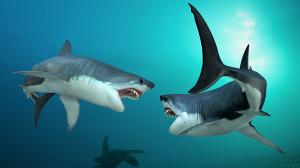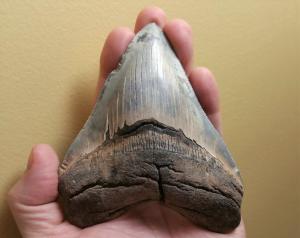Did Mega Shark Fight Mega Shark in the Prehistoric Seas? A Giant Tooth Tells the Tale
Did the bus-sized shark Otodus chubutensis clash with another colossal shark in the shallow waters of what is now central Florida?
BUCKINGHAM, PA, US, March 13, 2022 /EINPresswire.com/ -- Otodus megalodon, AKA Megalodon, AKA the “Meg”, was not the only giant predator roaming Miocene waters. From 28 to 5 million years ago, another monster of the deep swam the same seas. It was Megalodon’s close relative, and, arguably, its ancestor: the huge flesh-eater known as Otodus chubutensis.Chubutensis or, “The Chub”, was no slouch in term of size or ferocity. At up to 40 feet in length and weighing an estimated 20 tons, it was a whale-killing machine with cavernous jaws lined with triangular teeth up to 5.1 inches in length. Was there competition between the Chub and Meg? Did the two sharks ever clash over territory or fight over food?
A tooth in the collection of bestselling author and paleo-researcher Max Hawthorne may answer these questions. Known for his bestselling Kronos Rising series of sci-fi thrillers1, Hawthorne has established himself as a bit of a maverick when it comes to prehistoric marine life. While doing research for his novels, he has made some impressive paleontological discoveries. The animation for his theory on plesiosaur locomotion3 is featured in several UK museums, and was incorporated by the Harvard Museum of Natural History in a documentary on the pliosaur Kronosaurus2. He also has an extensive fossil collection, including a huge Chubutensis shark tooth that has its own story to tell.
“My Bone Valley Chub tooth is very interesting,” Hawthorne said. It’s a left-side, upper primary tooth, a number three, I should think,” he added, holding up the massive hunk of dentition. “At 4.75 inches, it’s sizable. But it wasn't the biggest tooth in the jaw. If, however, we compare it to matching teeth from complete sets of Megalodon, its close relative, we can extrapolate how big the biggest teeth in the Chubutensis's jaw would have been. They’d have come in at 5.1 inches, if not more, making the tooth’s former owner about as big as the species got. This was a very large shark.”
In terms of what the tooth tells us, Hawthorne elaborated. “This tooth was lost during biting. There is a strip roughly an inch in length along the distal edge of the crown, near the point, that shows a line of cuts in the enamel. These were caused by serrations from another shark tooth which, once the tooth was dislodged, tore along the edge of my tooth, leaving behind a distinctive pattern.”
He then asked the question: "Was it the same shark or another one? One often sees feeding damage like this with big shark teeth, but the damage tends to be a ragged pattern of deeper gouges, or even a split or break in the crown. In this case, the affected area shows tiny saw-blade-like nicks that were caused by another serrated tooth. The pattern is smooth, too, like the two teeth slid against one another and this one took damage. The unusual thing is that, when I compare the tiny notches cut into the tooth to its own serrations, the latter are smaller, roughly half the size.”
Does this mean the shark was attacked by another of its kind? Hawthorne said it’s a possibility. “Sharks are territorial, and there is often interspecies and intraspecies competition. White sharks, for example, are size-oriented, with smaller fish giving way to larger ones. If they don’t, they often get a warning bite. In this case, it could be that this shark was attacked by or attacking another shark, and their jaws intersected briefly, resulting in teeth being lost.”
When asked what he believes happened, and whether the other shark was a Megalodon, Hawthorne said, “It’s possible. If a Chub tried partaking of a carcass a Megalodon had claimed, a confrontation could have occurred. The strange thing is, however, that both of those species have fine serrations on their teeth, like hacksaw blades. This damage looks like it was caused by something with more coarse serrations, like those you’d see on a Great white shark.” He added, “There were prehistoric white sharks back then, and they were bigger than the extant variety. But in terms of what actually took place, it’s impossible to say; we can only theorize. It could be that the tooth was damaged by its former owner in some odd way. It could be a really big white shark came at the significantly larger Chubutensis and was driven off. Or it’s possible that two adult Chubs or a Chub and a Meg clashed and they both lost some teeth. Given that the two species swam side by side for 18 million years, the likelihood of that last one happening is an almost certainty. And now, we just may have proof.”
Kevin Sasaki
Media Representative
+1 267-337-7545
email us here
Visit us on social media:
Facebook
Twitter
Other
WATCH NOW: Max Hawthorne's KRONOS RISING: KRAKEN (volume 3) official book video trailer at https://www.youtube.com/watch?v=wJqRayk-D8s&t=3s

1 https://www.kronosrising.com/
2 https://www.youtube.com/watch?v=MLs6IYqxPR0
3 https://www.youtube.com/watch?v=vC_jDSE40As



